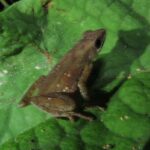- Introduction: Unveiling a Rainforest Mystery
- Taxonomy and Classification: Finding Family among Diverse Frogs
- Natural Habitat: Hidden among Brazil’s Atlantic Forest
- Physical Characteristics: Small Amphibian, Big Impact
- Behavior and Life Cycle: Secrets Beneath the Forest Canopy
- Ecological Role: Guardians of Forest Balance
- Threats and Conservation Status: Protecting This Delicate Existence
- Cultural and Scientific Significance: Why <em>Ischnocnema randorum</em> Matters
- Conclusion: Appreciating and Safeguarding a Forest Gem
Introduction: Unveiling a Rainforest Mystery#
Hidden among the lush leaf litter and dense foliage of Brazil’s Atlantic forest lies a tiny amphibian with an outsize importance—the obscure yet fascinating frog species, Ischnocnema randorum. Remarkable in its survival strategies, coloration, and habits, this diminutive creature offers scientists invaluable ecological clues and enchants nature enthusiasts lucky enough to encounter its cryptic presence.
First described scientifically in 2011, Ischnocnema randorum remains relatively unknown beyond the specialized circle of amphibian researchers and dedicated naturalists. Yet, its story—woven into the tapestry of Brazil’s biodiversity—deserves to resonate more widely. From its secretive behavior to its critical ecological role, exploring the life of this amphibian offers deeper insights into the remarkable biodiversity of Brazilian forests and the threats that challenge their survival.
Taxonomy and Classification: Finding Family among Diverse Frogs#
The frog Ischnocnema randorum belongs to the family Brachycephalidae, a distinct and captivating lineage of neotropical amphibians. Within this family, Ischnocnema is a remarkable genus characterized largely by direct-developing frogs—those that do not pass through a free-swimming tadpole stage but instead hatch directly into miniature versions of adults, already adapted for life on land.
The family Brachycephalidae is renowned for its diversity and specialized adaptations to unique ecological niches in Central and South America. Alongside closely related species such as Ischnocnema henselii and Ischnocnema parva, the enigmatic I. randorum contributes essential genetic diversity within the rainforest ecosystems of Brazil.
Natural Habitat: Hidden among Brazil’s Atlantic Forest#
Ischnocnema randorum occupies a particularly fascinating ecological niche within the highly diverse yet threatened environments of Brazil’s Atlantic Forest, situated along the eastern coastline and mountainous backdrops of Brazil. Primarily dwelling in the State of Rio de Janeiro, this species thrives in subtropical moist lowland forests and montane rainforest areas, characterized by moderate temperatures, high humidity, and frequent cloud formations.
A Life Amongst the Leaf Litter#
This species is rarely found basking openly, preferring instead the shadowy refuge provided by deep layers of fallen leaves, decomposing logs, and rocky outcrops scattered across the forest floor. Such microhabitats provide necessary cover from predators and harsh climatic conditions, while maintaining the humidity levels critical for their delicate, permeable skin to absorb moisture directly from their surroundings.
The dense foliage of Brazil’s Atlantic Forest offers perfect camouflage, shelter and adequate food resources, making it a highly specialized environment ideal for the survival of this elusive species. When sunlight pierces the dense canopy above, creating dappled patterns along the forest floor, these frogs remain almost perfectly hidden, blending seamlessly into rich brown and mossy green hues of leaf litter and moss coverings.
Physical Characteristics: Small Amphibian, Big Impact#
The most captivating aspect of Ischnocnema randorum lies in its small yet sophisticated physical form. Adult frogs rarely exceed 20 mm, placing them among the smaller but not the smallest members of their family. Their delicate stature belies surprisingly efficient adaptations, essential for survival amid a complex, competitive rainforest ecosystem.
Masters of Camouflage#
An intricate mosaic of colors adorns their tiny bodies, designed specifically for blending into dense foliage and moist ground cover. Shades of brown, green, and mottled gray allow these little amphibians to become practically invisible amid decaying leaves, mosses, and damp rocks. Their skin, smooth yet mottled, aids in moisture retention, allowing them to inhabit areas where water is available in the humid atmosphere rather than standing pools or flowing streams.
Sophisticated Adaptations#
Large eyes set upon this small frog’s face offer a keen sense of perception, enhancing their ability to detect predators and prey within their shadowy world. The limbs of I. randorum feature subtle yet highly specific adaptations; slender yet muscular legs offer remarkable jumping and maneuvering capabilities, critical both for escaping predators and capturing prey in the leaf litter environment. The digits of these limbs end in rounded, slightly swollen pads helpful for secure footing on slippery vegetation.
Behavior and Life Cycle: Secrets Beneath the Forest Canopy#
As with many forest floor amphibians, relatively little is publicly documented about the secretive behavior patterns and reproductive mechanisms of Ischnocnema randorum. Nonetheless, careful observations have provided a glimpse into the incredible, unconventional methods this species employs to breed and survive.
Unique Reproductive Tactics#
Unlike typical frogs, I. randorum bypasses an aquatic larval stage entirely. Rather than laying eggs in water, the female deposits small, moisture-dependent eggs directly into damp, shady hiding places on the forest floor. The fascinating phenomenon of direct development then unfolds—embryos develop directly into fully formed, tiny frogs within these egg capsules without ever becoming tadpoles.
Diet and Foraging Habits#
Ischnocnema randorum primarily preys on insects and small invertebrates living in the leaf litter and beneath decaying logs; their diet includes ants, beetles, mites, and tiny spiders. Active mainly during twilight hours, they leverage their camouflage and stealth to ambush prey passing close to their sheltered hiding places, plucking the unsuspecting prey swiftly and efficiently with a sticky tongue.
Ecological Role: Guardians of Forest Balance#
Despite their small size, frogs like Ischnocnema randorum fulfill a crucial ecological role as regulators of insect populations within rainforest ecosystems. By managing insect communities, they help balance complex food webs, ensuring the overall health and quality of their intricate habitats.
Their presence also offers essential cues for ecologists and conservationists. Amphibians are highly sensitive to environmental changes due, in part, to their permeable skin and reliance on consistent humidity and moderate temperatures. This sensitivity means they serve crucial functions as indicator species—warning us when practices in surrounding habitats are unsustainable or potentially damaging.
Threats and Conservation Status: Protecting This Delicate Existence#
The Atlantic Forests of Brazil have experienced severe deforestation, agricultural expansion, and urban encroachment, making fewer safe havens accessible for frogs like Ischnocnema randorum. Habitat degradation comes alongside climate change and fungal diseases such as chytridiomycosis, collectively presenting a serious challenge.
Currently, the International Union for Conservation of Nature (IUCN) has classified I. randorum as Data Deficient due to limited information concerning its exact population trends and full geographical range. This lack of data underscores the necessity for additional research efforts, habitat protection measures, and targeted conservation plans necessary for protecting its fragile existence and the Atlantic Forest’s unparalleled biodiversity.
Cultural and Scientific Significance: Why Ischnocnema randorum Matters#
While small and seemingly inconspicuous, Ischnocnema randorum symbolizes the hidden beauty and biological richness of Brazil’s forests, serving as an emblem of broader ecological preservation efforts. Scientific study of this species sheds essential insights into adaptive biology, ecological health indicators, and potential medicinal and scientific discoveries inherent to amphibian biology writ large.
Conclusion: Appreciating and Safeguarding a Forest Gem#
At the intersection of scientific wonder and conservation urgency, each amphibian species, particularly one as specialized and delicate as Ischnocnema randorum, reminds us of our collective responsibility towards safeguarding biodiversity. Whether through advocacy, research support, or responsible ecological management, each action taken contributes to preserving creatures like this enigmatic rainforest inhabitant.
By raising awareness, championing conservation efforts, and continuing documentation and study, we collectively ensure a brighter, more resilient future not only for Ischnocnema randorum but also for all hidden treasures tucked away within our planet’s most remarkable forests.







